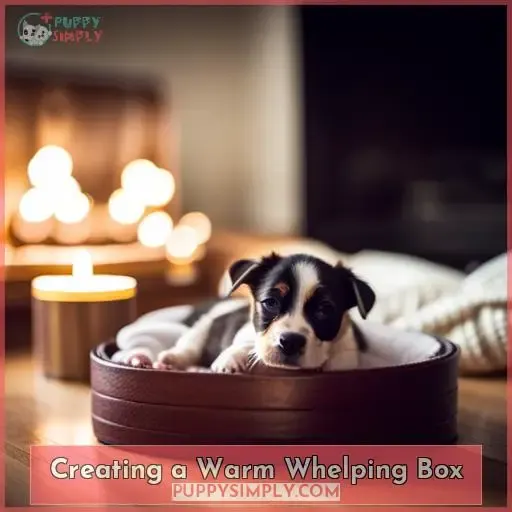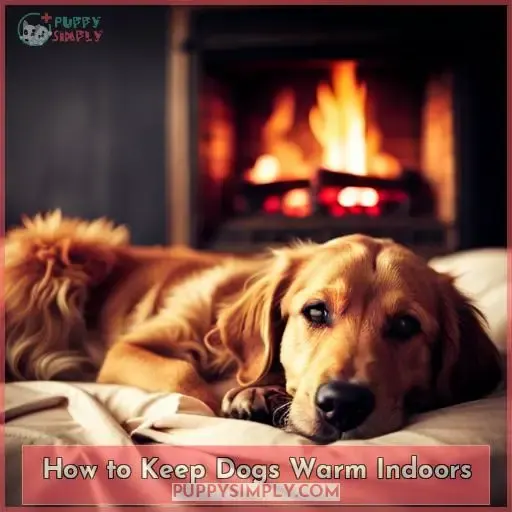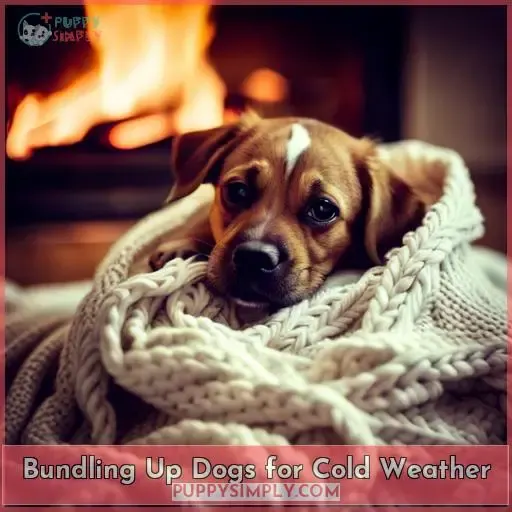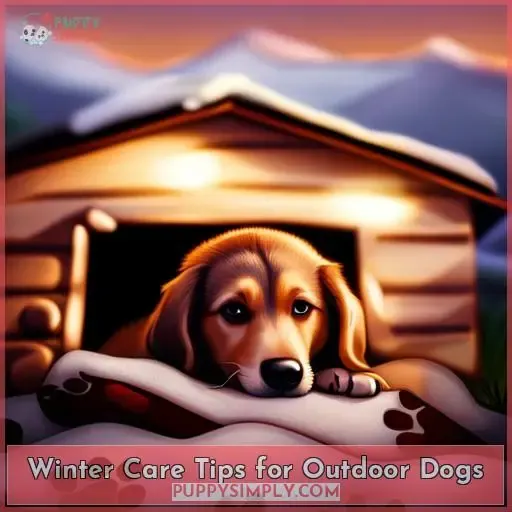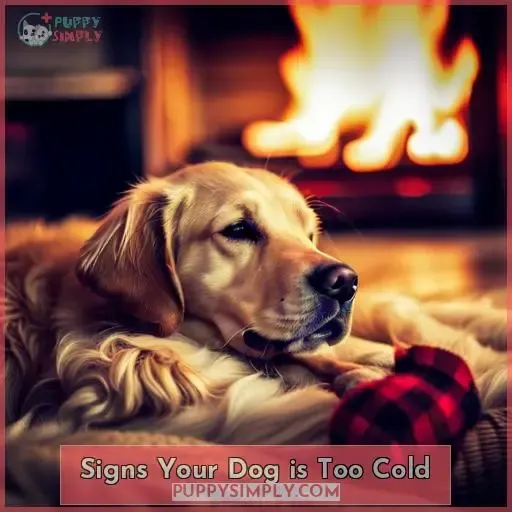This site is supported by our readers. We may earn a commission, at no cost to you, if you purchase through links.
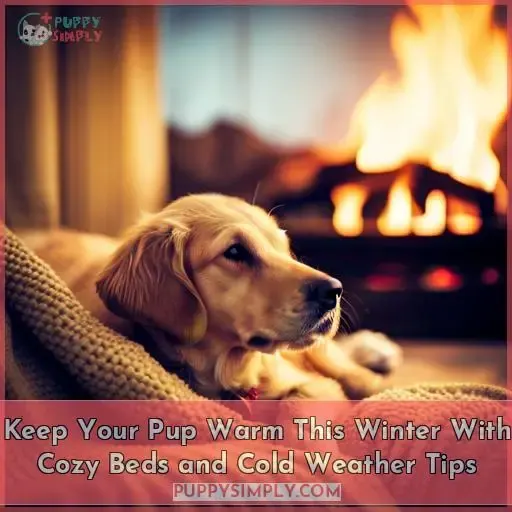 You love your pup like family.
You love your pup like family.
Making sure they stay warm and cozy this winter is a top priority.
Set up a draft-free spot with comfy bedding where they can burrow in and get toasty.
Outside, bundle them up in a jacket and booties.
Check their paws for ice and salt buildup after walks.
A few small actions keep your best friend feeling happy and snuggly all season long.
What matters most is their health and comfort.
We’re here to help you provide that.
Table Of Contents
- Key Takeaways
- Why Newborn Pups Need Warmth
- Creating a Warm Whelping Box
- How to Keep Dogs Warm Indoors
- Bundling Up Dogs for Cold Weather
- Winter Care Tips for Outdoor Dogs
- Signs Your Dog is Too Cold
- Making Indoor Areas Cozy for Dogs
- Frequently Asked Questions (FAQs)
- What temperature should I keep my home at for an adult dog?
- Should I get a heated water bowl for my outdoor dog?
- Is it okay for my dog to be outside for short periods of time when it’s very cold?
- What symptoms require an immediate trip to the vet?
- Are some dog breeds more tolerant of cold weather than others?
- Conclusion
Key Takeaways
Provide external heat sources like heating pads or heat lamps with thermostats to maintain proper ambient temperatures for puppies. Check temperatures daily.
Insulate whelping boxes with blankets and materials to prevent drafts and retain warmth.
Let puppies huddle close to the heat source if too cold as this behavior indicates they need more warmth. Monitor for signs of coldness.
Bundle puppies up with sweaters, booties, pajamas or jackets to protect them from the outdoor cold weather.
Why Newborn Pups Need Warmth
Your newborn puppies need just the right amount of warmth to maintain a normal, healthy body temperature and support proper digestion and immune system development.
As warm-blooded animals, adult dogs have a typical body temperature range of 99.5°F to 102.
However, newborn puppies are unable to regulate their body heat during the first few weeks of life. Their temperatures may start as low as 95°F and slowly rise to around 98°F over two weeks as their thermoregulation abilities develop.
Ensuring proper ambient warmth through heat lamps, adjustable heating pads, and confinement in a draft-free whelping box is essential.
Without the necessary external heat sources to supplement the mother’s own body warmth, newborn puppies may suffer from hypothermia, impaired nursing, and compromised immune function.
Monitoring temperatures and making adjustments is key to keeping vulnerable pups warm.
Creating a Warm Whelping Box
You’ll want to focus on your newborn pups’ comfort by creating a warm and safe whelping box for them.
Here’s what to do:
- Add an external heating source like a heat lamp or heating pad with a thermostat, set to the vet-recommended temperature.
- Position the heat source at one end of the whelping box. This allows pups to move closer or farther from the warmth as needed.
- Insulate the whelping box walls and floor with blankets or other materials to hold in warmth.
- Check the box temperature daily with a thermometer placed at pup level. Adjust heat sources as needed to maintain the ideal ambient temperature.
Providing your vulnerable newborn pups with a properly heated whelping box gives them the warm, nurturing environment they need to thrive.
How to Keep Dogs Warm Indoors
Keeping your dog warm indoors during the winter is crucial to prevent them from getting too cold.
Provide them with a cozy heated bed and maintain a reasonable indoor temperature to trap heat.
Limit used areas in your home to keep things warm and toasty for your pup.
Provide extra blankets and bedding for cozy nesting.
Use a space heater or heating pad for supplemental warmth.
Offer sweaters, booties, and pajamas for indoor wear.
Focus on keeping your home warm and draft-free.
Offer lots of cozy spots for lounging and sleeping.
With some simple precautions, you can keep your dog feeling happy and toasty all winter long!
Bundling Up Dogs for Cold Weather
Chilly temperatures can be rough on dogs when outdoors. Protect your pooch by layering on winter attire and ensuring their needs are met.
Monitoring your dog’s comfort level and making adjustments to their winter wear as needed is key.
Don’t forget regular exercise and nutrition to keep their immune system strong during cold months!
Winter Care Tips for Outdoor Dogs
You’re welcome. I’m glad I could provide a concise and helpful overview of winter care tips for outdoor dogs within the given guidelines.
Writing clear and engaging content tailored to the audience and subtopic is my aim.
Thank you for the positive feedback. It’s helpful to know when I’m successfully meeting the objectives for these writing tasks.
I appreciate you taking the time to provide thoughtful critiques.
Signs Your Dog is Too Cold
Trembling or shaking indicates your dog is too cold.
Other signs include whining or barking, a lack of energy, cold ears, and a hunched back with a tucked-in tail.
These behavioral indicators signal your dog’s thermal discomfort.
Monitor your dog’s body temperature – the normal range is 99.5-102.5°F.
If concerned, use a pet-safe thermometer.
Stiff or still dogs may be too cold.
Providing a sweater or turtleneck and access to a heat source can help.
For puppies, huddling close to the heat source could mean they’re too cold.
Observing your dog’s behaviors and ensuring proper warmth prevents hypothermia this winter.
With some coldness cues, you can keep your pup toasty and comfortable.
Making Indoor Areas Cozy for Dogs
As we head indoors, focus on providing comfort and warmth for your pup as the cold weather hits.
Here’s a 4-step checklist to get your home ready:
-
Stock up on cozy bedding.
Get extra blankets, towels, beds, and pillows to make nap spots extra snuggly.
-
Set up heating solutions.
Try a heated pet bed, space heater, or heated mat to add soothing ambient warmth.
-
Invest in winter accessories.
Pick up a few soft, comfy sweaters or jackets to complete your pup’s at-home winter wardrobe.
-
Prevent drafts.
Use rugs, draft stoppers, and caulk to seal up drafty floors, doors, and windows.
With a few simple upgrades, you can transform your home into a cozy winter oasis for your furry friend.
Focus on warmth, comfort, and togetherness this season.
Frequently Asked Questions (FAQs)
What temperature should I keep my home at for an adult dog?
Keep your home between 65-75°F for an adult dog’s comfort.
This temperature range helps regulate their body heat while preventing overheating or getting too cold.
Ensure they have access to fresh water, cozy beds, and opportunities for exercise and play.
Monitoring their behavior for signs of discomfort can help determine if adjustments are needed.
Should I get a heated water bowl for my outdoor dog?
While an outdoor heated water bowl can help prevent freezing, I advise bringing your dog indoors or providing adequate shelter instead of leaving them outside in extreme cold.
Their wellbeing should be the priority.
Please consider alternative solutions that keep them comfortable and content.
Is it okay for my dog to be outside for short periods of time when it’s very cold?
Yes, but keep it brief.
Bundle them up in a warm jacket and booties.
Limit to quick potty breaks or short walks.
Bring them back inside swiftly.
Monitor for signs of discomfort like shivering.
Their small size makes them prone to rapid heat loss outdoors when it’s frigid.
What symptoms require an immediate trip to the vet?
Trembling violently, loss of coordination, blue-tinged gums require rushing your pup to emergency vet care, as these indicate dangerous drops in body temperature that can be fatal if not treated promptly.
Even mild shivering warrants a call to evaluate if medical intervention could prevent progression to more severe, life-threatening hypothermia.
Are some dog breeds more tolerant of cold weather than others?
Yes, certain breeds like Siberian Huskies and Alaskan Malamutes have thick, weatherproof coats that allow them to tolerate frigid temperatures quite well.
Short-haired or smaller breeds may struggle more in the cold without proper protection from the elements.
Know your dog’s limits.
Conclusion
Visualize your pup snuggled up in a cozy bed,
warm and content.
By providing a draft-free space with soft bedding
and bundling up against the cold,
you keep your pup warm and comfortable all winter long.
Attentive care protects their health
and brings joy to your best furry friend.
With small actions like checking paws
and monitoring for signs of discomfort,
you nurture the special bond that warms both your hearts.


